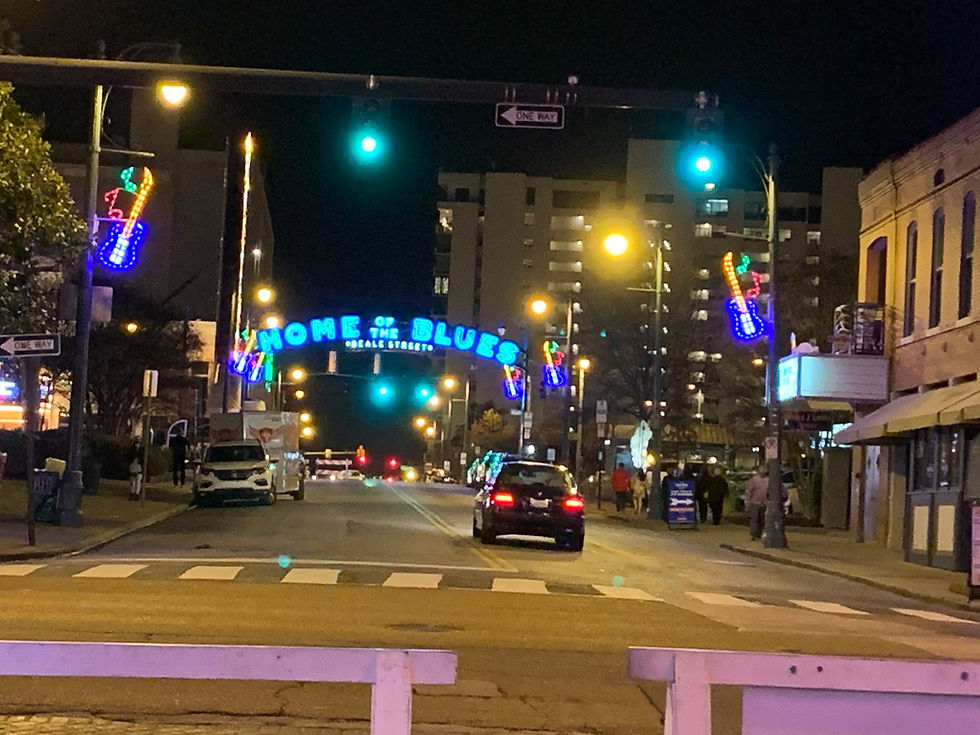A Few “Lesser Known and Obscure Facts” (I learned) about the Mississippi River, and its Inhabitants.
- Connard Hogan

- Jan 6, 2022
- 4 min read
Updated: Aug 26, 2022
Bottom line: In spite of COVID risks, we took measures to protect ourselves and enjoyed our trip.
During our “Christmas on the Miss” cruise, Janet and I traveled on the American Duchess down the Mississippi River from Memphis, TN to New Orleans, LA, known by locals as NOLA.
1) The Duchess is a stern-wheeler, with two wheels side by side located at the stern, as opposed to one paddle wheel on each side of the boat, aka a side-wheeler.

Janet poses with the American Duchess docked in Greenville, MS.
2) Headwaters of the Mississippi River flow from a spring that feeds Lake Itasca, Minnesota, elevation 1,475 feet. With a length of 2,341 miles, the Mississippi drops 7.560871422 inches per mile until it merges with the Gulf of Mexico beyond New Orleans.
3) The “Duck March” at the Peabody Hotel in Memphis is quite popular among people . . . as well as the ducks.
Peabody Hotel Duck March in Memphis,TN.
4) The Blues City Cafe in Memphis doesn’t believe in customers going away hungry. When I inquired about possible menu misprints, the waitress said, “We don’t have (ounce) steaks.” I thought better of ordering their largest sirloin. Then, the waitress mentioned something about a family meal. Indeed!

Really? Never mind the shrimp, fish, and chicken.

Beale and Main Streets near the Blues City Cafe in Memphis.
5) Janet and I "toured" the World's First Billy Bass Adoption Center at the Flying Fish Restaurant in Memphis.

The main Billy Bass display wall in the Flying Fish Restaurant.

Wouldn't cha' know? Another Elvis Impersonator!
6) Janet had to visit Elvis' Graceland. She just had to, no ifs, ands, or buts.

Elvis' Graceland home is much like many pre-Civil War
plantation homes across the deep south, after a fashion.
7) Elvis' taste in home decorating, 1970s era, was nothing to envy.

Elvis' 1970s Media Room (pre-internet social media).
8) Elvis owned and traveled via two planes.

The Lisa Marie, largest of Elvis' two jets.
9) Elvis owned horses, and purchased numerous cars and motorcycles during his short career. I can't comment about the color of his horses, as I saw none, but his choice of Cadillac color suggests he believed if you got it, flaunt it.

Elvis' Pink Cadillac.
10) The Delta, aka Yazoo-Mississippi Delta, of some 70,000 sq miles of alluvial floodplain in Arkansas, Louisiana, and primarily Mississippi, should not be confused with the Mississippi River Delta, which terminates some miles beyond New Orleans.
11) The Delta suffered major flooding in 1927, the most destructive in US history, when the levee first failed near Mounds Landing, some 17 miles from Greenville, Mississippi. Some areas were covered by as much as thirty feet of water and at least two months elapsed before the floodwater completely subsided.

The Mississippi Delta, not to be confused with
the Mississippi River Delta southeast of NOLA.
12) Greenville, Mississippi, boasts of “more published writers per capita” than any other town in the US, such notables include Shelby Foote.
Their published author's list as displayed at the
Greenville Writers Exhibit at the Percy Library.
13) Many consider The Delta as the birthplace of Blues music, and highly influential in the development of Rock and Roll, if not its birthplace as well.
14) The Mississippi River temporarily ran backwards after a series of New Madrid fault earthquakes between December 16, 1811 and February 7, 1812. Additionally, those tremors created 18-mile-long Reelfoot Lake in TN.

Reelfoot Lake near Tiptonville, TN. Note: Photo taken during a separate trip.
15) The NMSZ, New Madrid Seismic Zone, is not benign nor dormant. Ruptures have occurred numerous times and have been felt and recorded in personal journals as far away as Louisville, Kentucky and Cincinnati, Ohio.
16) Though many consider cotton the primary crop of the pre-Civil War South, corn and sugarcane figured prominently. Corn fed farm animals and sugarcane helped fuel the opulent plantation culture built upon slave labor. Touring a few notable houses on our trip, I was reminded of European royal palaces.

Nottoway Plantation Mansion. Note: Gentlemen, please
ascend on the right as to not glimpse bare feminine ankle.
17) Gators love marshmallows. Wait . . . why are they called “marsh” mallows?

Several swamp gators compete for a marshmallow. Note: the brown &
green is vegetation reflecting off the water, not muck in the water.
18) Cafe Du Monde’s beignets, French doughnuts, aka fritters, are popular in the French Quarter of NOLA. Janet and I opted to stand in the take-away line for almost an hour to purchase an order, as the sit-down line appeared longer. I’m sure both lines had formed hours before our arrival, with customers placing and consuming their orders all the while. And when Janet and I left, the lines had grown longer still.

Queue for Cafe Du Monde beignets when Janet and I arrived on the scene.
19) Janet and I found the World War Two Museum in NOLA interesting, as we spent nearly a whole day there. I liked the museum's display of US WWII planes.

Surely, that Avenger wasn't dropping a live bomb.
Probably not. Well, maybe not. I hoped not, anyway.
20) I'd expect to be hanged and quartered, if I didn’t mention Southern and Cajun cuisine, other than that above. Both Janet and I enjoy Cajun food, though only lightly spiced. However, Janet shies away from deep-fried breaded items, particularly catfish. Her catfish aversion has something to do with owning a pet catfish years ago, but that didn't deter me, at least on one occasion.

Prepared to chow down on fried alligator, crab cake and raw oysters, Connard photo
bombs Janet's foodie picture at the Coterie Restaurant & Oyster Bar, NOLA.
Note: Gator tastes like a cross between chicken and ground beef to me.







Comments